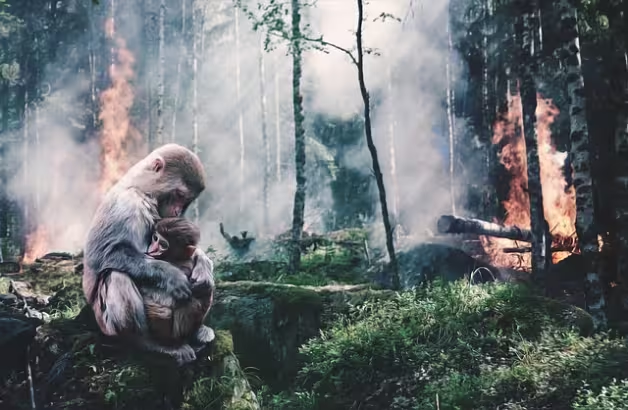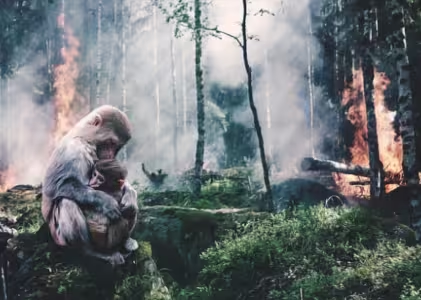Effects of Deforestation on Biodiversity – Imagine this, waking up in the morning, going outside, and finding every single tree in the neighbourhood completely gone: no birds chirping, no rustling of leaves through the wind, no shade from the burning sun.
The quiet would be surreal-as if the air was thinner, not as alive. Then scale that out to an entire planet. That is our reality with deforestation, and it’s not just an environmental disaster’s life and death for countless species, ecosystems, and, eventually, for us.
Effects of Deforestation on Biodiversity
Deforestation involves something far more serious than the simple act of cutting down trees. It destroys the entire ecosystems that took millions of years to evolve.
Visualize a huge, complex jigsaw puzzle comprising innumerable animals, plants, and insects living together symbiotically. We remove just one simple tree, and we are not only removing one piece from this jigsaw but throwing it out of kilter.
Every tree maintains an entire network of life. Birds harness sustenance from their branches, insects find abundant life in their bark, and the innumerable organisms from visible to microscopic make their leaves, roots, and fruits their home. The cutting of these trees upsets these precariously balanced relationships. We are not merely cutting wood; we are severing lifelines.
The Domino Effect: How Deforestation Affects Biodiversity
I was utterly shocked when for the first time, I heard about the impacts of deforestation. Impacts which were far-reaching at the least. You cut down just one tree, and that affected species many hundreds of miles away. Here is how:
Habitat Loss:
Well, isn’t it? Seriously, though, think of more than 80% of the world’s terrestrial animals and plants that call forests their home. In this process, when forests are destroyed, the animals lose shelter, sources of food, and breeding grounds. It’s a tragic death spiral for many species.
Fragmentation:
It is the breaking down of a city into smaller pieces, detached neighbourhoods, avoiding the roads around it. Animals which need larger territories to find either food, mates, or simply to migrate remain jammed in this respect. It is like living in your house with no groceries, healthcare, or work. It is an extremely slow death sentence given to so many species.
Forests are the lungs of Earth, and by chopping them down, we unleash carbon stored in trees back into the atmosphere, adding up in a way that speeds up global warming. A warmer world disrupts ecosystems, shifts migrations, and sends weather patterns haywire furthering the threat to species.
Changes in Water Cycles:
On the cycling of water, trees form an indispensable component of the ecosystem. In their absence, rainfall patterns get altered, and rivers dry off. Water, in consequence, will get scarcer. Species depending on such water sources will, quite literally, be left high and dry.
Case Study: The Amazon Rainforest – A Dying Giant?
Normally, the Amazon Rainforest would be referred to as “the lungs of Earth” and one of the most biodiverse places on our planet; it is a home for around 10% of all known species, many of which are found nowhere else. This hallowed place, however, seems to be being torn through at an alarming rate.
It works out that, over five decades, more than 17 per cent of the Amazon was lost, according to a report by the World Wildlife Fund. That’s an area roughly the size of Texas. And when the trees fall, they take whole ecosystems with them. Jaguars, toucans, and tree frogs are losing their homes at a pace they cannot adapt to.
Most species are threatened, not just threatened to disappear, but they are on the very verge of disappearing forever.
As Dr. Thomas Lovejoy once warned very well-reputed ecologist and expert on the Amazon-“We’re getting very, very close to a tipping point beyond which we’ll lose the Amazon as we know it.”
What that means is, that beyond a certain point, the rainforest cannot regenerate. It could morph into a savannah-like expanse, vastly decreasing its ability to support life and absorb carbon dioxide.
Expert Opinion: What the Scientists Are Saying
I spoke to the world-renowned primatologist and environmentalist Dr Jane Goodall, who has witnessed the marks of deforestation in Africa. “Every tree cut down, every forest cleared, is a wound to the planet,” she said.
It is not the number of trees cut down or the area of forests; it is the relationships that sustain life, communities of plants and animals disrupted, delicate balance collapsed that keeps everything in check.
Specialists say it’s not only an ecological calamity but a biodiversity tragedy. And this is happening at a rate incomprehensible to the human brain. According to the World Resources Institute, 2019 had one of the worst rates of deforestation ever measured. We lost in just one year an area of forest the size of Switzerland.
Why Should We Care? – The Human Cost
The forests are not only nice to view but also offer us clean air, fresh water, and medicines that treat everything from headaches to cancer. When we destroy the forests, the benefit derived may be irretrievable.
More than 25 per cent of modern medicines come from rainforest plants. With each felled tree, we can be losing the cure for diseases we have not even discovered.
It doesn’t stop there: forests are home to millions of indigenous people who rely on them for their way of life. It would push people out of their homes into circumstances whereby culture, language, and heritage could be irretrievably lost.
What Can We Do About It?
The scale of the problem can feel overwhelming; there are steps, however, that we can take.
- Support reforestation programs: the Rainforest Alliance and One Tree Planted are doing some great work reforesting where possible. Every tree counts.
- Reduce using paper and wood: use recycled products, and if possible, support companies with committed sustainable practices.
- Support policy changes: Governments have to start taking stricter action with logging and land use. Our voices can help push these changes.
- Educate and Spread Awareness: Spreading information, talking about issues related to deforestation, and making it a point to enlighten others would help a lot. After all, knowledge is the first step toward action.
More From Us
Breakthroughs In Wave Energy Harvesting
How Solar Paint is Revolutionizing Renewable Energy
Amazing Science Facts For Students
Frequently Asked Questions on Effects of Deforestation on Biodiversity
1. What do you consider the main causes of deforestation?
Deforestation may be caused by many different reasons, mainly for agriculture, including commercial and subsistence farming; logging, which is the extraction of wood; infrastructure expansion; and even wildfires. These activities free up space for farms, cities, and resources where forests once had existed.
2. What happens to carbon dioxide in trees?
Trees absorb carbon dioxide. When they are cut down, the capacity of those trees to store carbon is lost, and the carbon stored is released into the atmosphere, thereby increasing global warming.
3. Can deforestation be reversed?
Yes, to an extent. We plant trees, which means reforestation, and we also create new forests, which is afforestation. It is, however, an extended process involving time, resources, and dedication.
4. Which species are most in danger as a result of deforestation?
Species such as the orangutan that rely on specialized habitats, such as that of Southeast Asia, are particularly at risk. Many species of amphibians, birds and insects also face critical threats.
The Bottom Line on Effects of Deforestation on Biodiversity
Deforestation has a catastrophic, long-lasting and ultimately self-destructive impact on biodiversity. For each tree that falls, so much more than just wood is lost-but a part of our world. We really cannot afford to look the other way in this time of crisis. Now is an excellent time to take action. For if we do nothing, then it may be that one morning we will wake up and find ourselves having lost so much more than we ever imagined.


